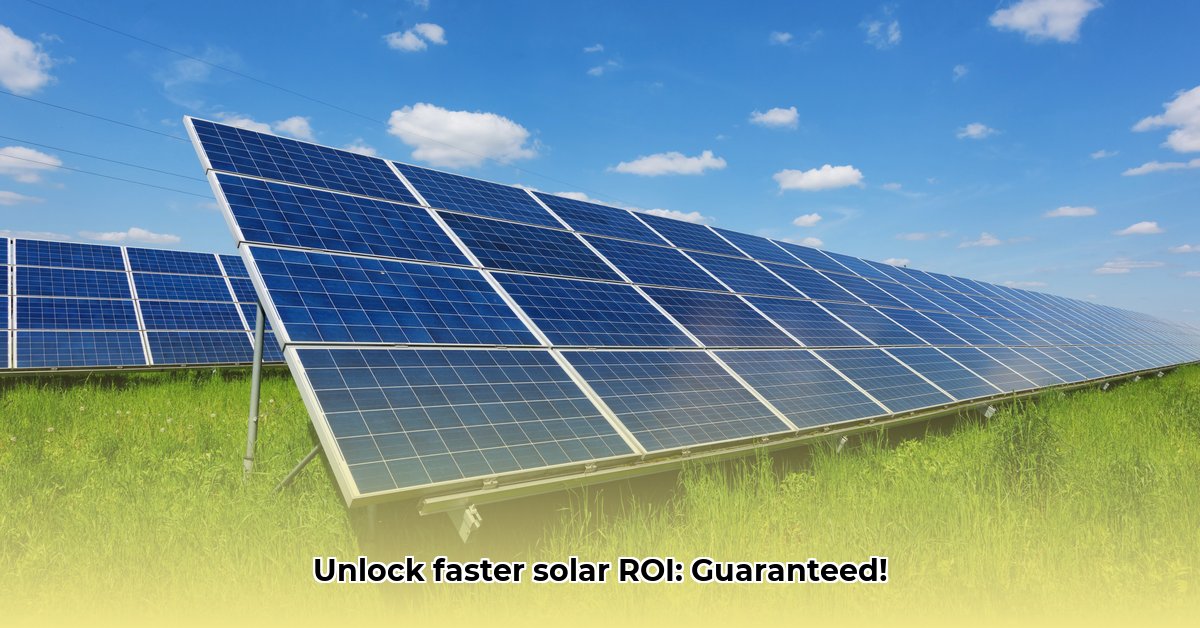Considering going solar? It’s a significant investment, and understanding the financial implications is key to making an informed decision. This guide provides clear, actionable insights to help you maximize your solar energy return on investment (ROI) and avoid common pitfalls. We’ll explore factors influencing ROI, compare returns across different regions, and offer a step-by-step plan to calculate your potential savings.
Solar Energy Return on Investment: Your Fast Track to Savings
Thinking about harnessing the power of the sun? It’s more than just an environmentally conscious decision; it’s a strategic financial move. This guide is designed to help you navigate the complexities of solar ROI, turning sunlight into tangible savings for your pocket.
Decoding Your Solar ROI: It’s Personal
While the national average solar ROI hovers around 10%, remember that your situation is unique. Several factors determine your individual payback period. These include the amount of sunlight your location receives (solar irradiance), your energy consumption habits, the efficiency of your solar panel system, and any government incentives available to you. These government incentives may greatly improve solar power payback times.
Location plays a vital role. For instance, sunny regions like Southern California will naturally see faster returns compared to areas with more consistent sunlight. Consider your energy usage as well. A larger household using more electricity will require a bigger system, potentially extending the payback period compared to a smaller household with lower consumption. Government incentives, such as tax credits and rebates, can dramatically reduce the initial investment, thereby boosting your ROI.
The Key Players in Your Solar ROI
Several interconnected elements affect home solar investment returns. Let’s break down the critical factors that will affect solar panel roi increase:
- Government Incentives: Federal and local tax credits, state-level rebates, and performance-based incentives like net metering can substantially lower your upfront costs and ongoing returns. Research the Database of State Incentives for Renewables & Efficiency (DSIRE) for incentives available in your specific area; they can significantly impact your ROI.
- Your Energy Hogs: The higher your electricity bills, the quicker you’ll witness a return on your investment. Evaluate your current energy consumption and anticipate future needs to choose a correctly sized solar system. Smart home devices and energy audits can help optimize energy use.
- System Sizing: Hitting the Sweet Spot: Choosing the appropriate system size is crucial for maximizing your ROI. Over-sizing leads to wasted energy (unless you have net metering), while under-sizing means you still rely on the grid. This involves carefully assessing your energy needs, for now, and in the future. Consider future electric vehicle purchases or the addition of a heat pump.
- Panel Tech: Efficiency and Longevity: Solar panels vary in efficiency, lifespan, and degradation rates. Higher-efficiency panels generate more electricity from the same surface area, accelerating your ROI; consider if the higher cost is justified by long-term gains. Look for panels with strong warranties (25 years or more) and low annual degradation rates (0.5% or less).
- Net Metering: Selling Back Your Excess Power: Many utility companies offer net metering programs that enable you to sell surplus solar energy back to the grid. This can substantially increase your savings and shorten your payback period through energy credits. Understand your utility’s specific net metering policies, including rates and any limitations on system size.
- Installation Costs: Labor costs can vary widely between installers. Get multiple quotes and research the reputation and experience of the installation company. Consider whether they are certified by organizations like the North American Board of Certified Energy Practitioners (NABCEP).
- Financing Options: Loans, leases, and power purchase agreements (PPAs) all have different implications for your ROI. Understand the interest rates, fees, and contract terms associated with each option. Direct ownership typically offers the highest ROI in the long run.
Short-Term Gains vs. Long-Term Vision: A Balancing Act
How do you view your solar investment? Will it influence your view on the ROI? In the short term, you’ll likely focus on immediate bill reductions and a fast payback. However, a long-term perspective highlights increased home value and consistent energy cost savings over the system’s 25-30-year lifespan. Additionally, consider the environmental benefits and contribution to a more sustainable future.
| Stakeholder Group | Short-Term Focus | Long-Term Focus |
|---|---|---|
| Homeowners | Lower energy bills; maximizing incentives; rapid payback period | Energy independence; enhanced home value; environmental benefits; legacy for future generations |
| Solar Installers | Competitive pricing; quick installation; high customer satisfaction scores | Building strong customer relationships; maintaining technological expertise; expanding service offerings |
| Local Governments | Promoting renewable energy; economic stimulus; reducing carbon footprint | Sustainable community development; job creation; resilience to climate change; improved air quality |
| Utility Companies | Managing grid stability with increased distributed generation | Exploring smart grid technology; adapting to a changing energy landscape; integrating renewable energy sources |
Navigating Potential Challenges: Smart Strategies for Success
While solar investments provide numerous benefits, be aware that challenges exist. Understanding these risks and planning mitigation strategies is essential.
| Potential Risk | Mitigation Strategies |
|---|---|
| Panel Degradation | Invest in high-quality panels with strong warranties; schedule regular maintenance checks; consider performance monitoring systems |
| Damage From Severe Weather | Ensure robust installation; secure comprehensive insurance coverage; choose panels rated for high wind and hail resistance |
| Changes in Government Policy | Stay informed about potential policy modifications; diversify investments; advocate for supportive policies |
| Grid Instability | Consider battery storage for energy independence; participate in demand response programs; ensure compatibility with grid standards |
| Supply Chain Issues | Work with established installers with reliable supply chains; consider purchasing equipment in advance; diversify suppliers |
| Shading | Conduct a thorough shading analysis; consider tree trimming or panel relocation; explore microinverters or power optimizers |
| Inverter Failure | Choose inverters with long warranties; consider extended service plans; monitor inverter performance |
| Roof Condition | Assess roof condition before installation and make any necessary repairs; ensure the roof can support the weight of the solar panels |
Your Action Plan: A Step-by-Step Guide to Solar Success
To maximize your solar ROI, follow these steps to prepare for the installation of efficient solar panels:
- Analyze Your Energy Use: Carefully examine your past electricity bills (at least 12 months) to ascertain your average energy consumption. This data is crucial for determining the appropriate system size. Use online tools or consult with an energy advisor to identify energy-saving opportunities.
- Investigate Incentives: Thoroughly research and understand federal, state, and local incentives for solar installations. Contact relevant government agencies and energy companies. Check the DSIRE database and local utility websites for the latest information.
- Assess Your Site: Evaluate your roof’s orientation, tilt, and shading. A south-facing, unshaded roof is ideal. Consider the age and condition of your roof, as it may need to be replaced before installing solar panels.
- Gather Multiple Quotes: Contact several reputable solar installers (at least 3-5) to obtain detailed proposals. Compare their offerings, including equipment quality, warranty terms, financing options, and installation experience. Ask for references and check online reviews.
- Analyze ROI Projections: Carefully review ROI projections provided by installers. Ask clarifying questions to understand the underlying assumptions and calculations, including electricity rate escalation, panel degradation, and maintenance costs. Use a solar ROI calculator yourself to verify their estimates.
- Understand Your Contract: Carefully review the contract with your chosen installer, paying close attention to details such as payment terms, warranty coverage, installation schedule, and dispute resolution procedures.
- Make an Informed Decision: Choose an installer and system that aligns best with your budget, energy needs, and long-term financial goals. Don’t be afraid to negotiate and ask for clarification on any aspect of the proposal.
- Monitor System Performance: After installation, monitor your system’s performance regularly to ensure it’s operating as expected. Many systems come with monitoring software that allows you to track energy production and identify any potential issues.
Calculating your solar ROI is a multi-faceted process. By diligently considering these factors and actively mitigating potential risks, you’ll be well-positioned to enjoy the financial and sustainable power of solar energy for years. The potential for long-term cost savings, a positive environmental impact, and increased energy independence makes solar energy a compelling investment for many homeowners.
How to Calculate Solar Panel ROI by State Considering Net Metering
Key Takeaways:
- Solar panel ROI varies significantly across different states, impacted by sunlight, electricity rates, and net metering policies.
- Net metering, where you can sell excess energy back to the grid, drastically enhances returns and shortens payback periods.
- Several factors influence the payback period, including system cost, energy consumption, and available incentives.
- Thorough planning and research are key to optimizing your investment and understanding state-specific regulations.
- Professional guidance can help you find the best solar savings rates and optimize your investment strategy.
Understanding the Variables
So, you’re considering solar energy? It’s a savvy move. But before you commit, it’s critical to create a realistic picture of your potential return.
- Hydro Extrusions USA Leads North American Aluminum Profile Solutions - December 28, 2025
- Hydro North America Leads Aluminum Extrusion Solutions Across Diverse Industries - December 27, 2025
- Hydro Extrusion North America Provides Custom Solutions Across Diverse - December 26, 2025
















